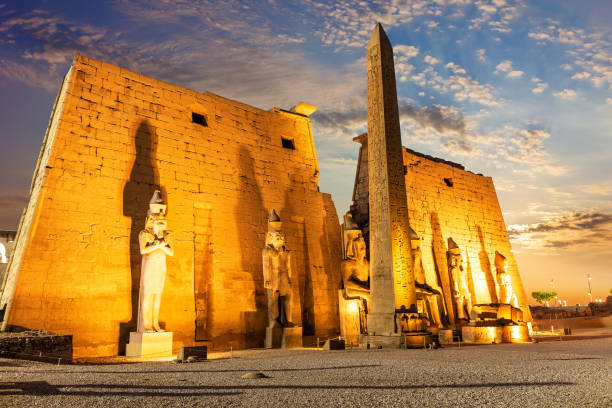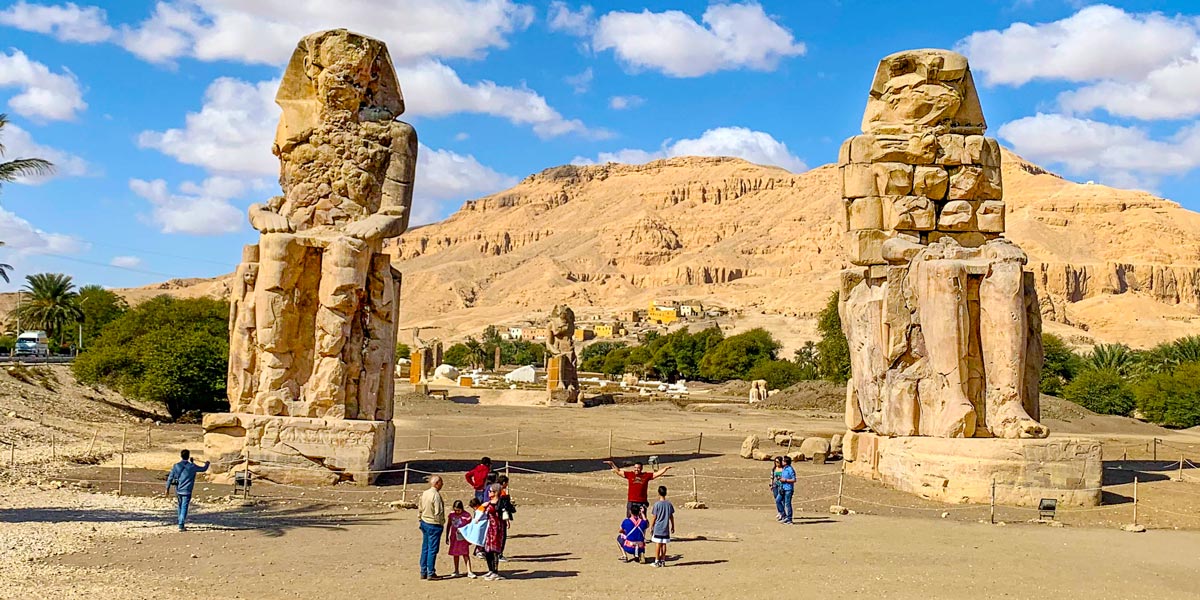Cultural, historical, adventure, and custom customized trips are just a few of the tours that Deluxe trips offer in Egypt and Jordan.

Luxor is aptly called the world's greatest open-air museum. With sites such as the world-renowned Karnak Temple complex, Valley of the Kings, and Temple of Hatshepsut, it whisks you into the grandeur of ancient Egyptian civilization. Here you walk among pharaohs' tombs, look at towering hieroglyphic-covered temples, and walk mythological ruins built by pharaohs Amenhotep III and Ramses II.
The city also offers a vivid cultural immersion—from browsing colorful local markets to savoring traditional Egyptian cuisine, you’ll encounter the warm spirit of daily life in Luxor. Situated along the lush Nile River, the region combines scenic landscapes with historical depth: enjoy serene river cruises, magical desert sunsets, and vibrant countryside views just beyond the temple walls.
Easily accessed some 675 km to the south of Cairo, Luxor is a fascinating addition to any tour of Egypt and can be accessed by flight, upgraded sleeper train, or road trip.
You can book:Splendid 8 days Cairo & Aswan to Luxor Dahabiya Tour
Renowned in the past as Thebes, Luxor was Egypt's grand political and spiritual capital of the New Kingdom (c. 1550–1070 BC). As the cult center for the deity Amun, the city saw the construction of large temple complexes like Karnak and Temple of Luxor, whose necropoles housed royal burials in the Valley of the Kings and Queens.
When the pharaonic period ended, Luxor was almost abandoned—until European tourists rediscovered and restored its monuments during the 19th century. Now its stunning archaeological heritage is a UNESCO World Heritage site, and it is among the world's leading holiday venues for tourists and history buffs.
Luxor lies in southern Egypt on the east bank of the Nile River, 420 miles (675 km) south of Cairo. Its early location provided it with a prominent religious, cultural, and political center. Luxor is a world destination for travelers today who come to witness its ancient ruins, tombs, and temples.
Yes—Luxor is a vacation must for everyone interested in ancient Egypt, archaeological ruins, and cultural heritage. From the intricately carved interiors of Karnak Temple and the atmospheric ruins of Luxor Temple to the dramatic tombs of the Valley of the Kings, you’ll discover well-preserved monuments that narrate millennia of history. Add in immersive experiences like Nile boat cruises, market visits, and local cuisine, and Luxor unlocks as a throbbing center for both history enthusiasts and adventure travelers alike.
We've categorized our top 15 Luxor tours by East Bank and West Bank attractions for your travel planning needs. Let's visit four of the East Bank's most visited attractions—before we hop across the Nile to discover the treasures of ancient riches on the West Bank. Plan your day to maximize the history, tours, and attractions of Luxor.
Cross the Nile to explore Luxor's West Bank, where iconic attractions such as the Valley of the Kings, Temple of Hatshepsut, and Colossi of Memnon are to be found. All these rank among the finest experiences that make Luxor a leading archaeological travel destination globally. Want me to expound on the Top 15 things to do in Luxor, including West Bank itineraries, locals' tips for transport, or gear-up accommodations
Perched on Luxor's East Bank, The Karnak Temple in Egypt Complex is among Luxor's most beautiful historic attractions. Across an enormous space is laid out this architectural complex comprising multiple temples, chapels, pylons, and halls that were first built over centuries as a site of worship in honor of god Amun‑Ra. Visitors are amazed by the legendary Great Hypostyle Hall, massive carved pillars covered with hieroglyphics—a must-see work of Mamluk craftsmanship and Pharaonic architecture. To complete your tour, purchase Precincts of Mut and Montu tickets, which are separately ticketed. Don't miss this treasure in your quest for "top things to do in Luxor."
South-east of Karnak is Luxor Temple, celebrated monument and sacred shrine dedicated to the Theban Triad of Amun, Mut, and Khonsu. Built in the New Kingdom, the temple played a central part in religious rituals such as the Opet Procession. Today, this beautiful Egyptian temple is celebrated for its colossal sandstone statues, decorated obelisks, and walls covered with hieroglyphics. Illuminated at sunset, Luxor Temple is full of romantic photo opportunity and remains one of the most atmospheric of the top attractions to see in Luxor.
Why visit? It's a great combination of history and atmospheric photography.
Delightfully situated on the East Bank of the Nile, the Luxor Museum houses a thoughtful assemblage of ancient Egyptian statuary, reliefs, and everyday objects of varied periods—covering from the Middle Kingdom to the Late Period. Well-preserved and well-displayed, the artifacts provide valuable testimony to Egypt's antiquity, art, culture, and skill. A visit to this serene Luxor Museum tour is a thoughtful supplement to temple sightseeing and one of the most educational activities in Luxor.
Recommended for: History lovers, art lovers, and travelers looking for more cultural insight.
Also within walking distance of Luxor Temple, on the East Bank, is the Mummification Museum, a fascinating insight into ancient Egyptian death traditions. The museum has preserved mummification equipment, teaching papyri, and actual mummies—giving the rare possibility of viewing and learning about the old folk's concept of death and afterlife. If you're looking for other and offbeat Luxor tourist attractions, this museum ranks high on that list.
This tiny museum is ideal for Egypt tourists interested in Egypt's ritual and mummification science.
The Valley of The Kings is a stunning necropolis in which Egypt's pharaohs—among them Tutankhamun and Ramses II—were buried in elaborately painted tombs. The valley holds over 60 royal tombs and is a testament to the peak of New Kingdom burial customs. More tombs to visit are the famous starry sky of Ramses VI and the highly colored tomb of Seti I. This legendary archaeological park is still one of the biggest attractions in Luxor, giving visitors history but also emotional intensity.
Situated close to the Valley of the Kings,The Valley of The Queens Egypt was the sacred cemetery for queens, princes, and royal princesses. The serene location has about 80 highly decorated tombs. One of the most notable is the Tomb of Nefertari with its beautiful murals of afterlife scenes from the Book of the Dead. Another important tomb is that of Amunherkhepeshef, a son of Ramses III. As one of the best historical attractions in Luxor, this site offers rare insight into regal roles and female symbolism in ancient Egypt.
Carved into towering cliffs near the Valley of the Queens, the Mortuary Temple of Queen Hatshepsut is a stunning tribute to one of Egypt’s most powerful female pharaohs. This architectural marvel features terraced colonnades and detailed reliefs chronicling the divine birth and reign of Hatshepsut. Dedicated to Amun, the temple is a profound example of New Kingdom architecture and royal iconography. Visiting this site remains one of the most enriching things to do in Luxor, combining scenic beauty with cultural depth.
Standing silently guard over the West Bank are The Colossi of Memnon Luxor, two enormous stone guardians once looking out over the destroyed mortuary temple of Amenhotep III. While the temple itself lies in ruin, these mythic 18-meter statues remain imposing sights for tourists passing through Luxor. With no entrance fee at the site, it's ideal for photo stopovers and jaw-dropping amazement at ancient Egyptian statuary proportions.

The Mortuary Temple of Ramesses III at Medinet Habu Temple is a stunning temple complex further south on the West Bank. Closed with top-notch reliefs, enormous pylons, and decorated chapels, it provides an intriguing insight into the life of Ramesses III and Egyptian war, festivals, and religion. One of the best archaeological sites in Luxor and among the best in Egypt, it's a place that should be visited by all tourists who have an interest in pharaonic religious and military culture.
About 60 kilometers north of Luxor lies the Dendera Temple Complex, Egypt's best restored temple, dedicated to the goddess Hathor, a music, joy, and love patron deity. The complex, a brilliant example of architectural preservation, is world-famous for its colorful ceiling murals, delicately styled reliefs, and lushly decorated hypostyle hall with sumptuous column furnishings.
Dendera Temple is a highly rated day trip from Luxor and ideal for those travelers interested in ancient Egyptian mythology and sacred architecture. You will have the opportunity to see zodiac sculptures, underground crypts, and Greco-Roman ruins.
What to wear at Dendera Temple? A hat, light dress, and walking shoes are essentials. Covering attire is recommended, especially for rural Egypt cultural respect.
Why Go? Dendera takes a close-up of life in an ancient Egyptian temple, with fewer tourists than Luxor's major sights.
Deir el-Medina, the Valley of the Artisans, is a hidden archaeological gem on Luxor's West Bank. It was the village home of the very skilled workers who constructed the Valley of the Kings and Queens royal tombs.
Walk through restored homes, brightly painted tombs, and communal buildings to experience daily life in ancient Egypt. These craftsmen's tombs are among the finest decorated in Egypt, depicting scenes of family life, work, and religious life at home.
Tip: A human insight into Egypt's ancient builders—this is one of the less-well-known things to do in Luxor.
The Ramesseum on the West Bank is the pharaoh Ramesses II, or "Ramesses the Great," tomb temple. The colossal ruin bears witness to the grandeur and power of one of Egypt's most legendary mythical rulers.Despite the fact that the major portion of the original structure fell in on itself, massive statues and handsome hieroglyphics remain. Highlights include a colossus of a shattered statue of Ramesses and relief photos of the Battle of Kadesh.Why go? This off-the-beaten-path location is best suited for visitors who are intrigued by the history of warfare in ancient times and stunning pharaonic architecture.
Visit the life of the iconic archaeologist at the Howard Carter House, close to the Valley of the Kings. This museum is located within the same house that Carter lived in when he discovered Tutankhamun's tomb in 1922.Within, find personal belongings, old excavation equipment, and photographs that provide a close examination of the find that transformed Egyptology.Recommended for: History buffs and real-life discovery enthusiasts—one of the most informative things to do in Luxor.
There's no experience quite like flying above Luxor's temples and tombs on a sunrise Hot Air Balloon adventure. Drift above stunning scenery such as the Valley of the Kings, the Temple of Hatshepsut, and the green farmland below as the golden sunrise breaks over the desert and Nile Valley. It's a stunning way to witness Egypt's ancient treasures from above, with stunning views and memories to last a lifetime.
Why it's worth it: One of the most unique things to do in Luxor, ideal for photographers or couples, or anyone with an adventurous spirit.
Embarking on a Egypt Nile River Cruises between Luxor and Aswan is a classic way to explore ancient Egypt’s most important sites. Whether aboard a modern cruise liner or a traditional felucca sailboat, you’ll witness timeless scenery and historic temples from the water.Along the journey, you’ll pass Karnak Temple, Edfu Temple, Kom Ombo, and end at Philae in Aswan. The calm pace allows time to soak in both history and luxury.Top reason to cruise: It's a relaxing and immersive way to travel while exploring UNESCO World Heritage Sites along the Nile.
Why Luxor Belongs on Every Traveler’s Bucket List
Luxor, or the world's best open-air museum, is a place of dreams for any person willing to discover the history, culture, and architecture of Egypt's ancient times. Located on the Nile riverbank in south Egypt, Luxor has some of the world's most renowned archaeological sites such as the Karnak Temple Complex, Valley of the Kings, Temple of Hatshepsut, and Luxor Temple. The city offers a perfect blend of stunning monuments, historically intact tombs, robust local culture, and stunning landscapes. While walking through the craft village of Deir el-Medina and sailing along the Nile River to soaring above the city in a hot air balloon, Luxor provides memories to treasure for history buffs, photographers, and adventure seekers.
Discover now our answers to the most common questions that may come to your mind about tourism and trips to Egypt
Cultural, historical, adventure, and custom customized trips are just a few of the tours that Deluxe trips offer in Egypt and Jordan.
The Dead Sea, Petra in Jordan, the Pyramids of Giza, Luxor's historic temples, and many other famous sites can be expected to be explored with Deluxe Tours.
offer a hassle-free holiday, Deluxe Tours' packages generally include lodging, transport, meals, guided tours with experienced local experts, and entry fees to attractions.
Spring (March to May) and fall (September to November) offer the finest weather for sightseeing and outdoor activities, making those months the best times to visit Egypt and Jordan.
These two countries are close by, only a 1.5-hour flight apart, and when combined, offer a variety of distinctive experiences. We advise you to spend at least 12 days visiting both countries for a truly unforgettable experience
Combining the eclipse viewing with visits to historic sites like the Pyramids of Giza, the Valley of the Kings, and a Nile River cruise are highly recommended.
